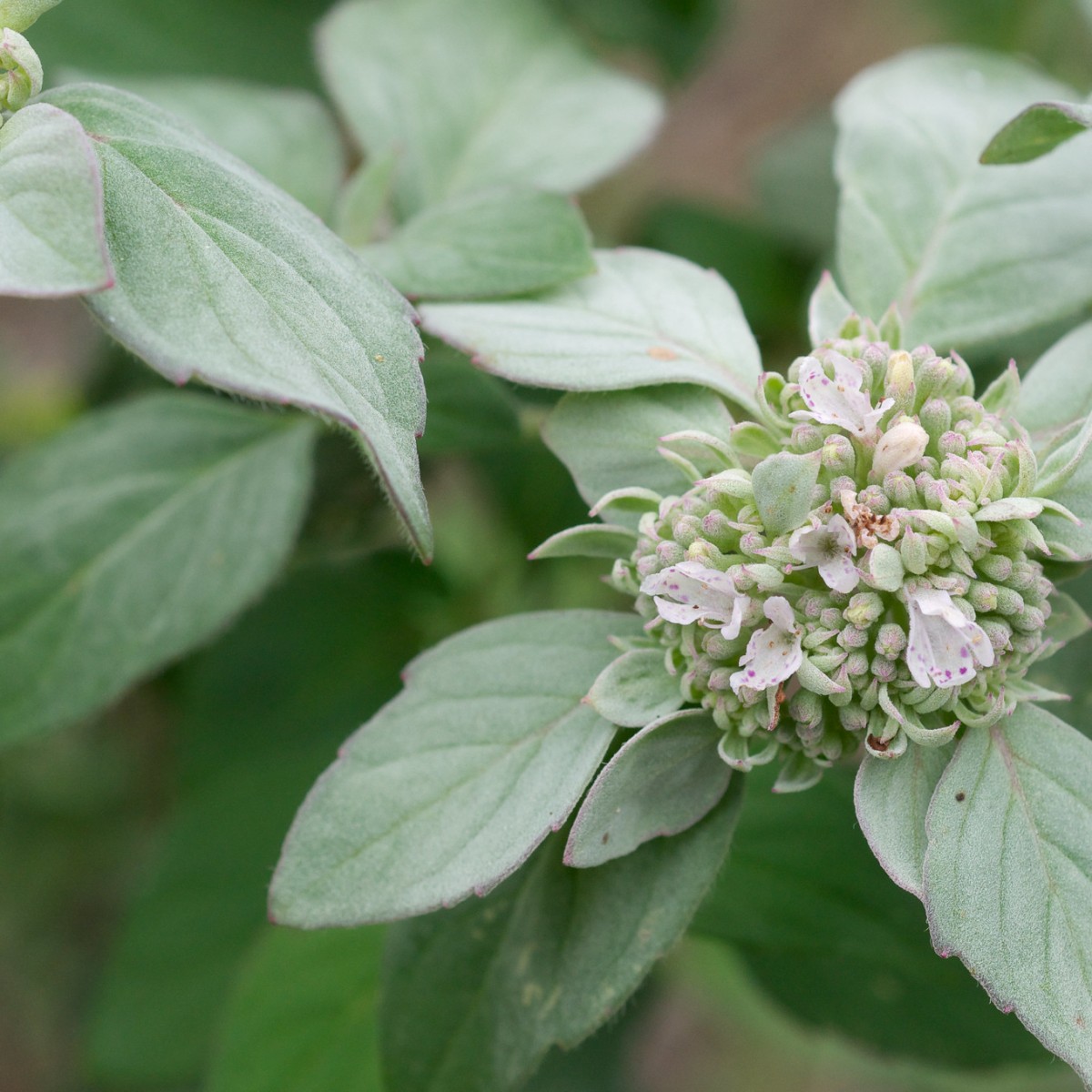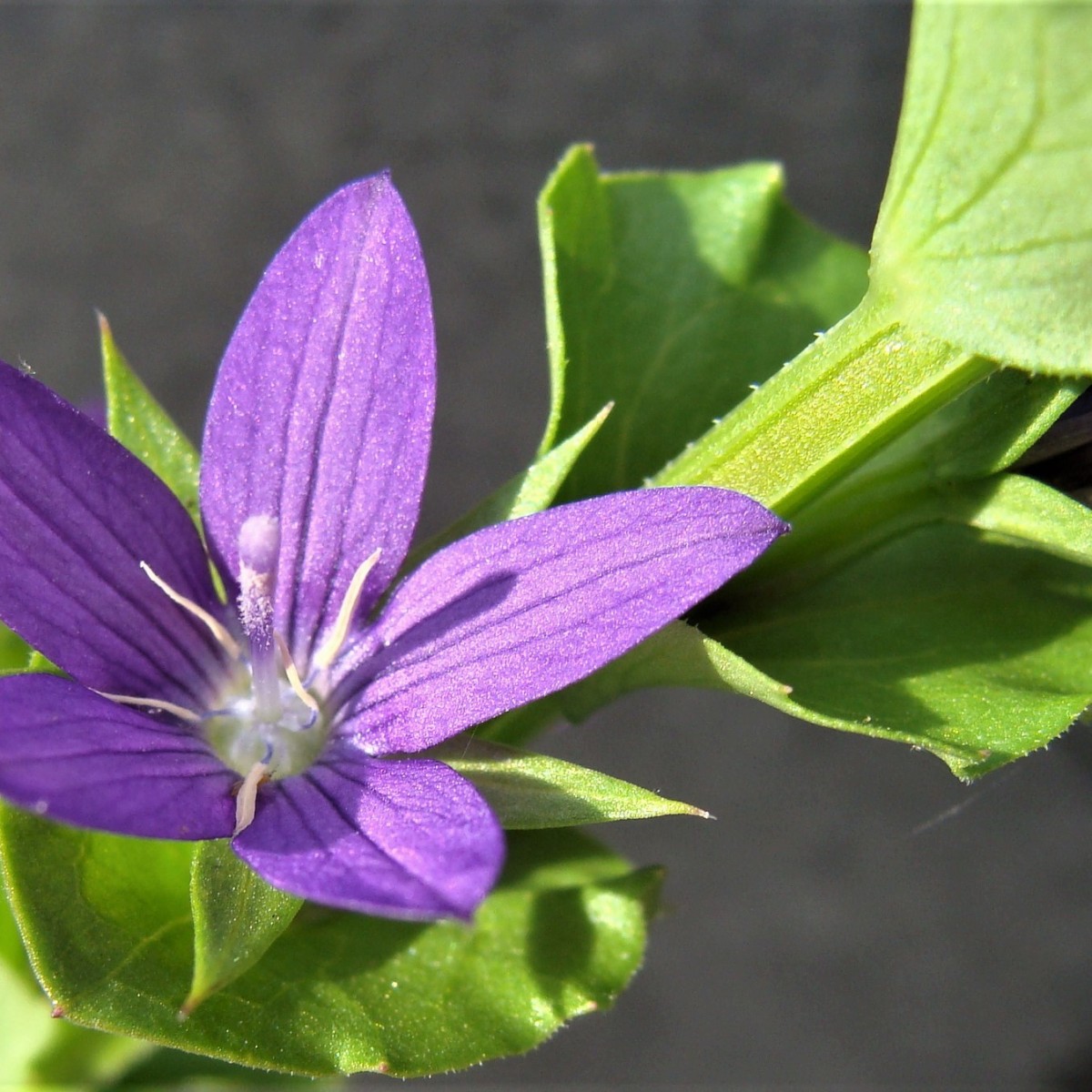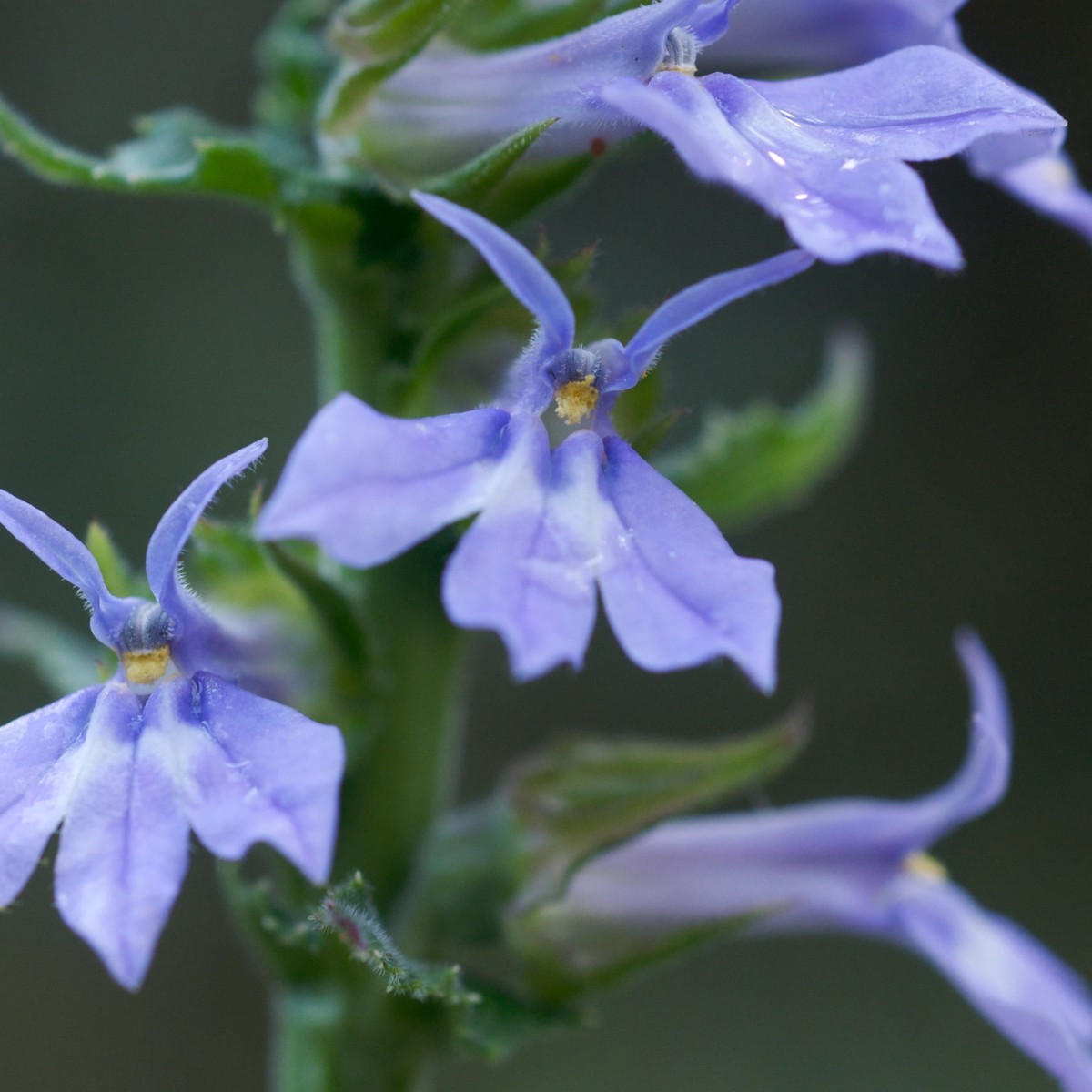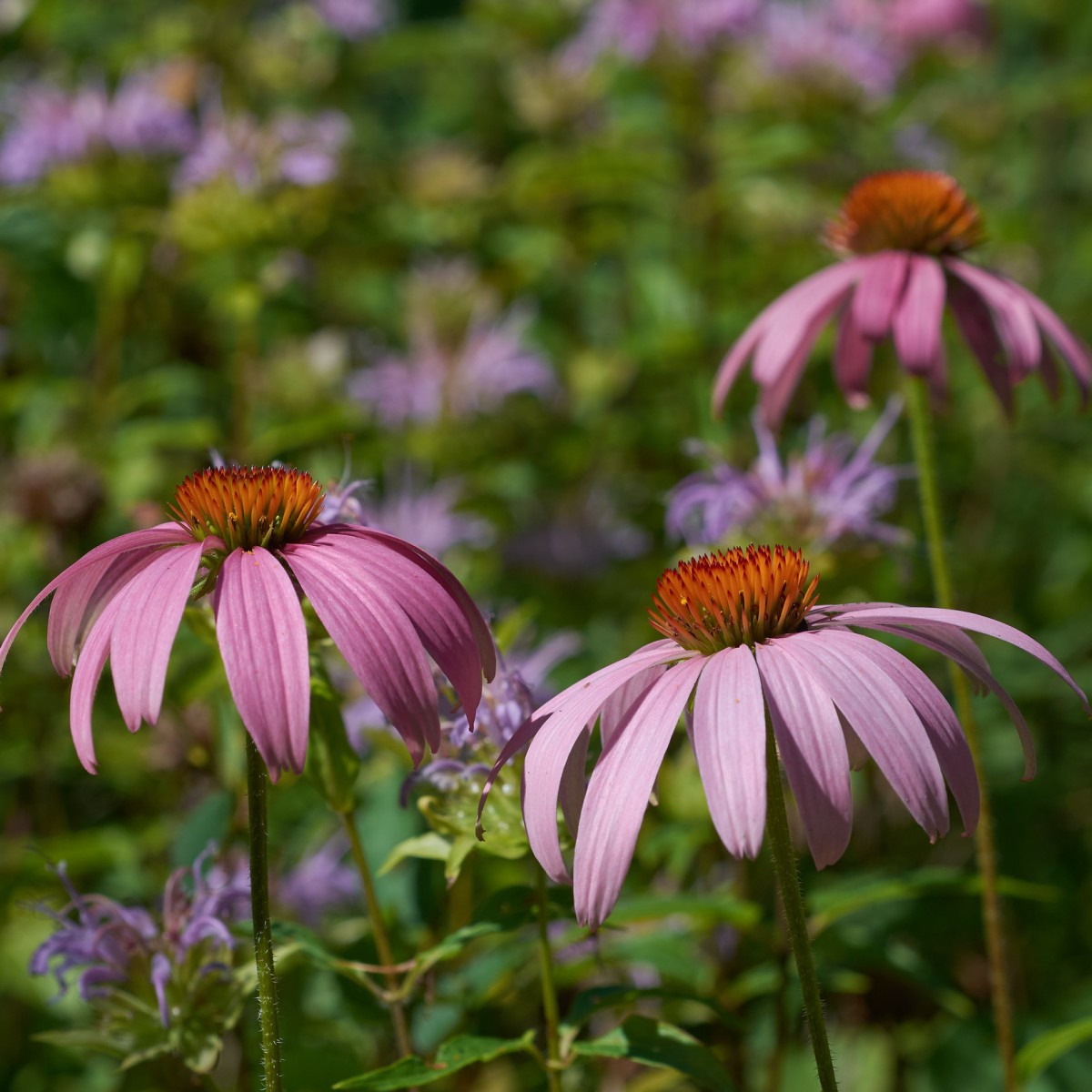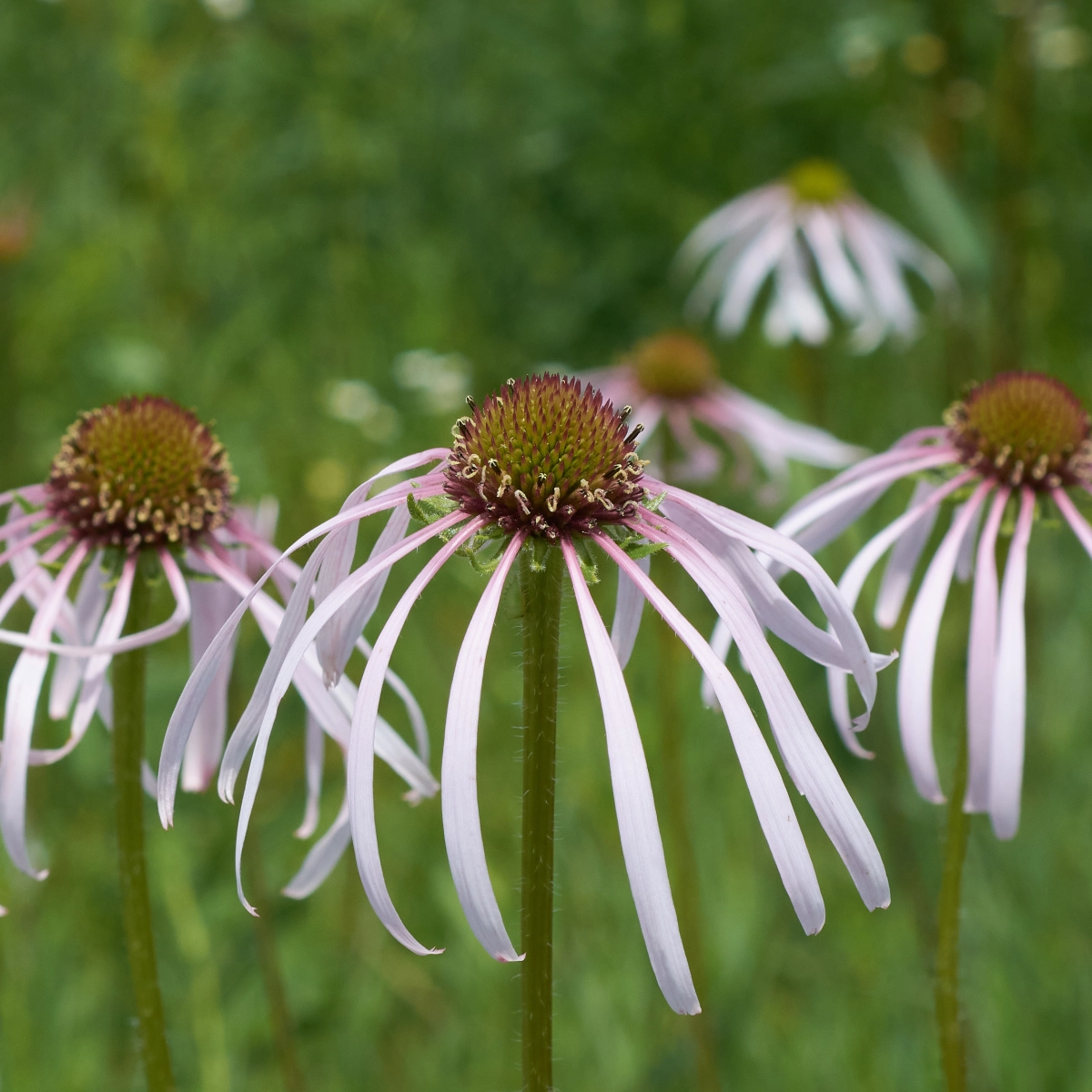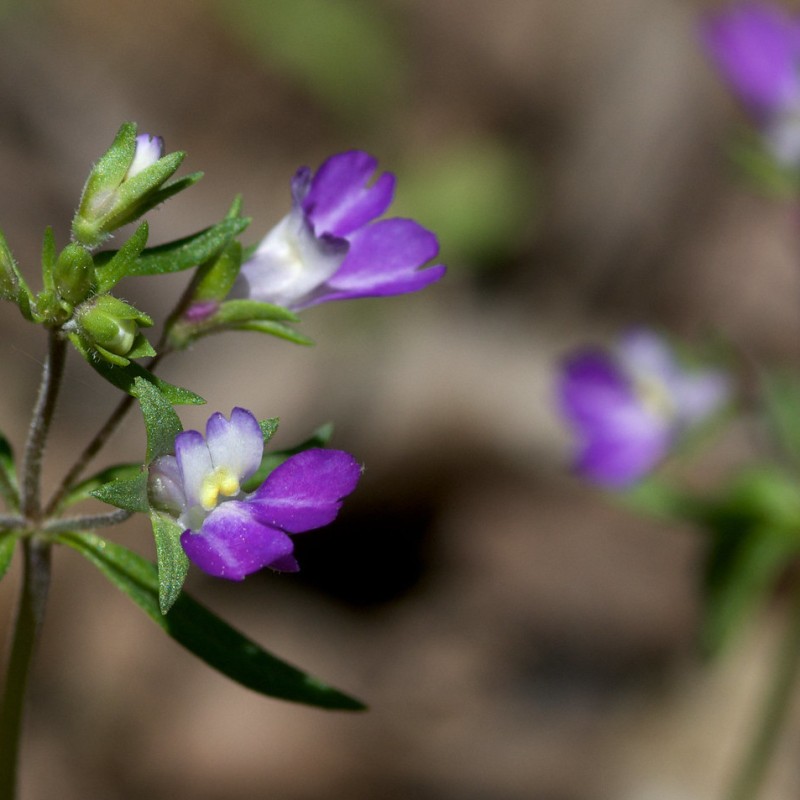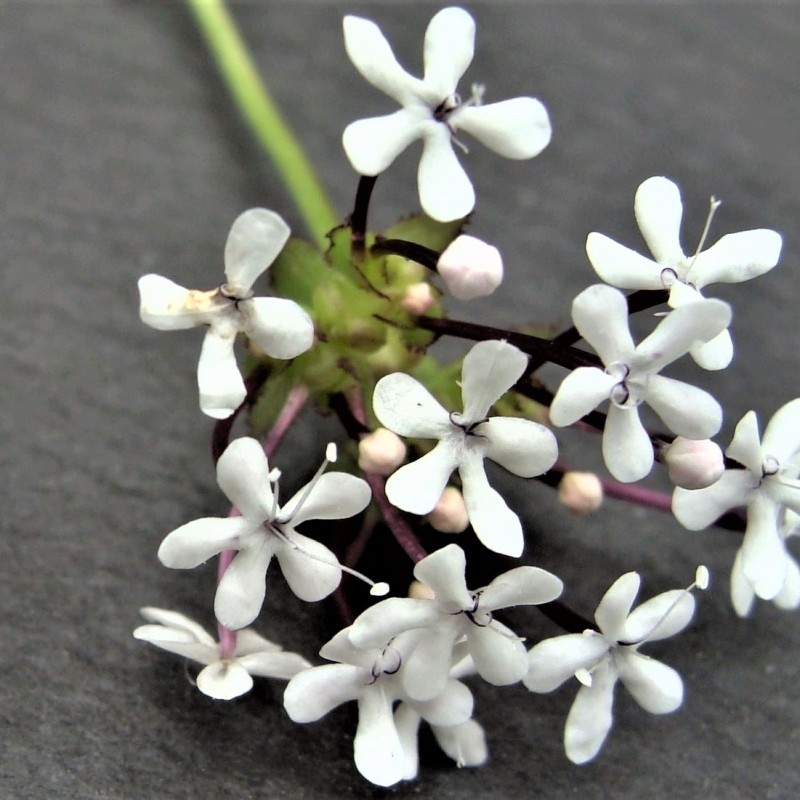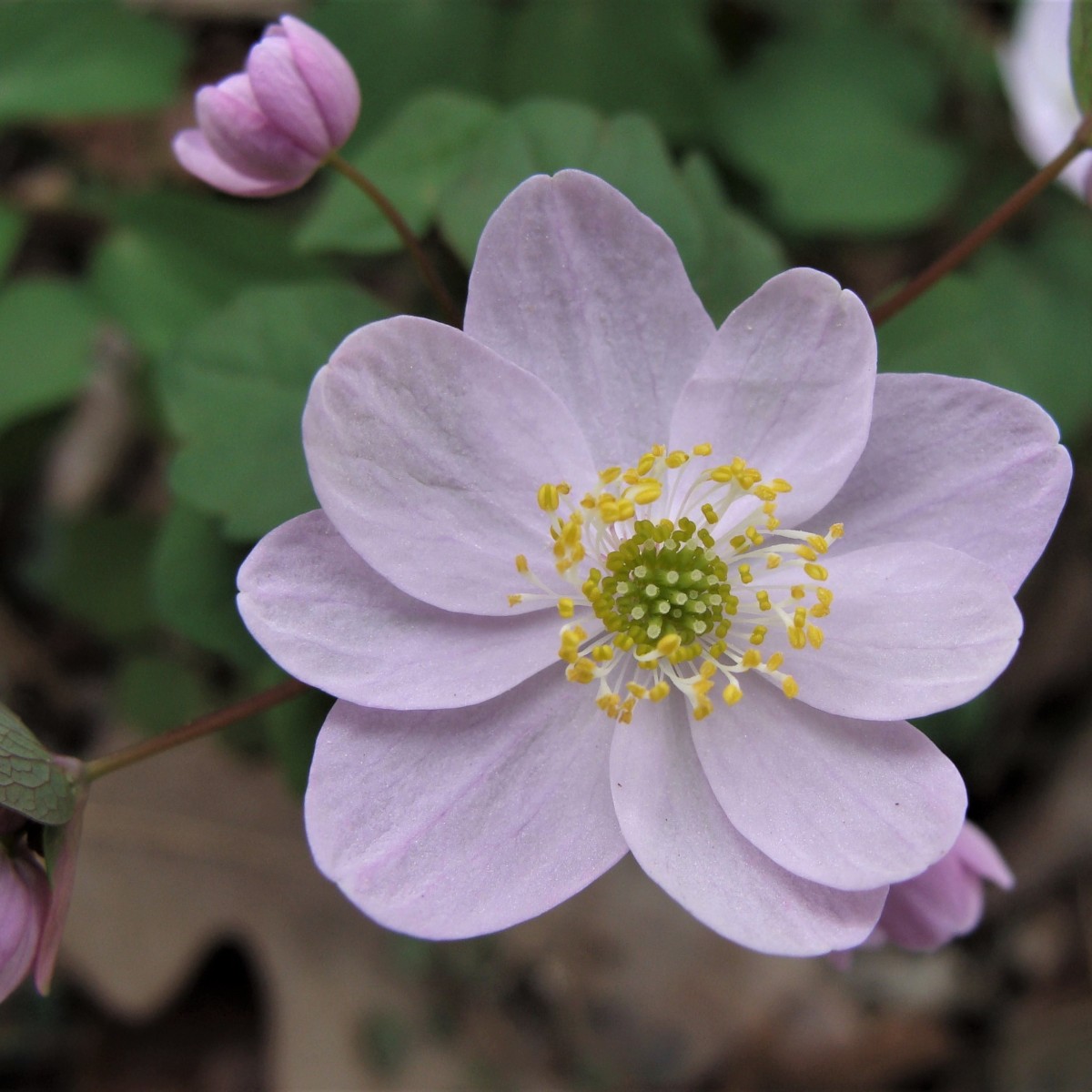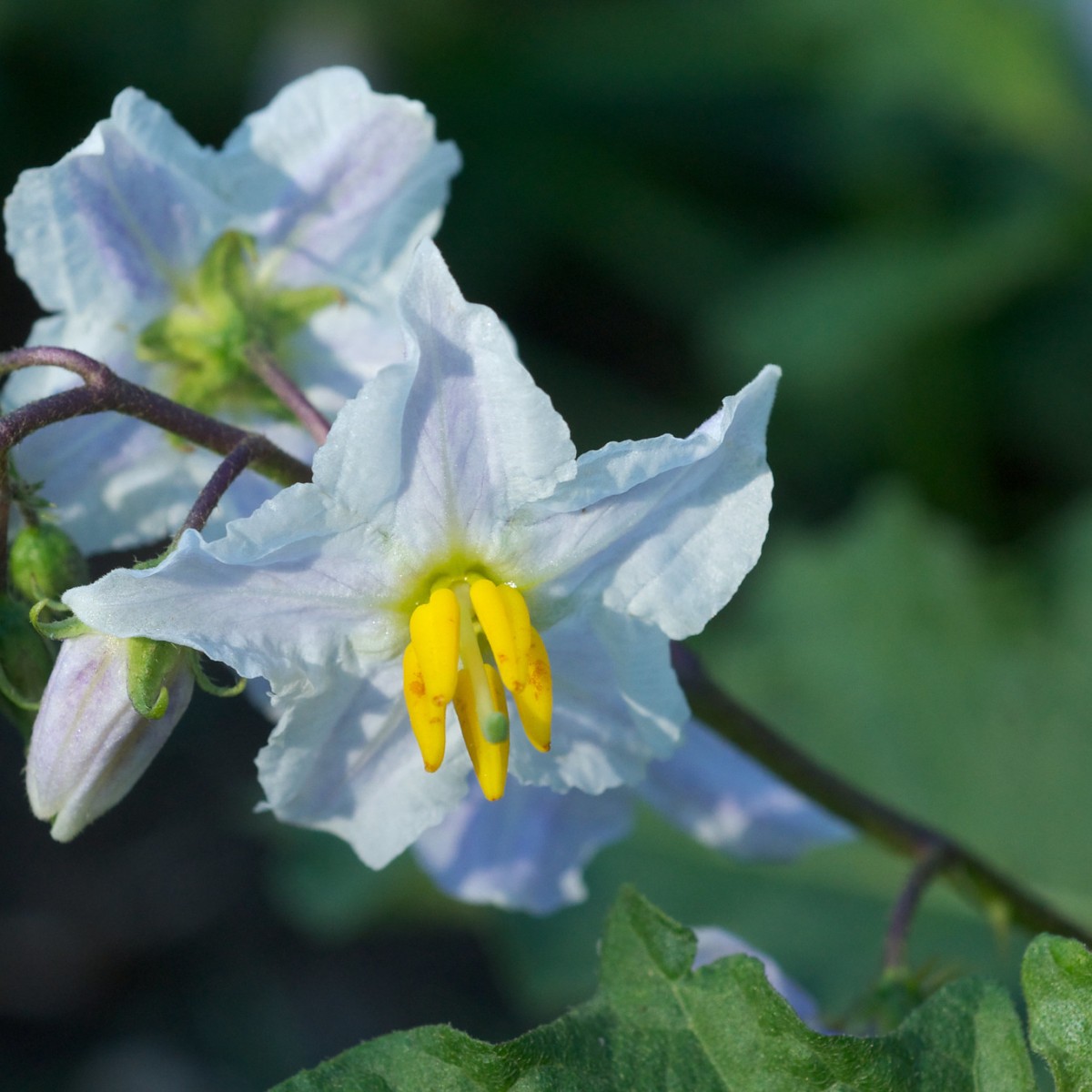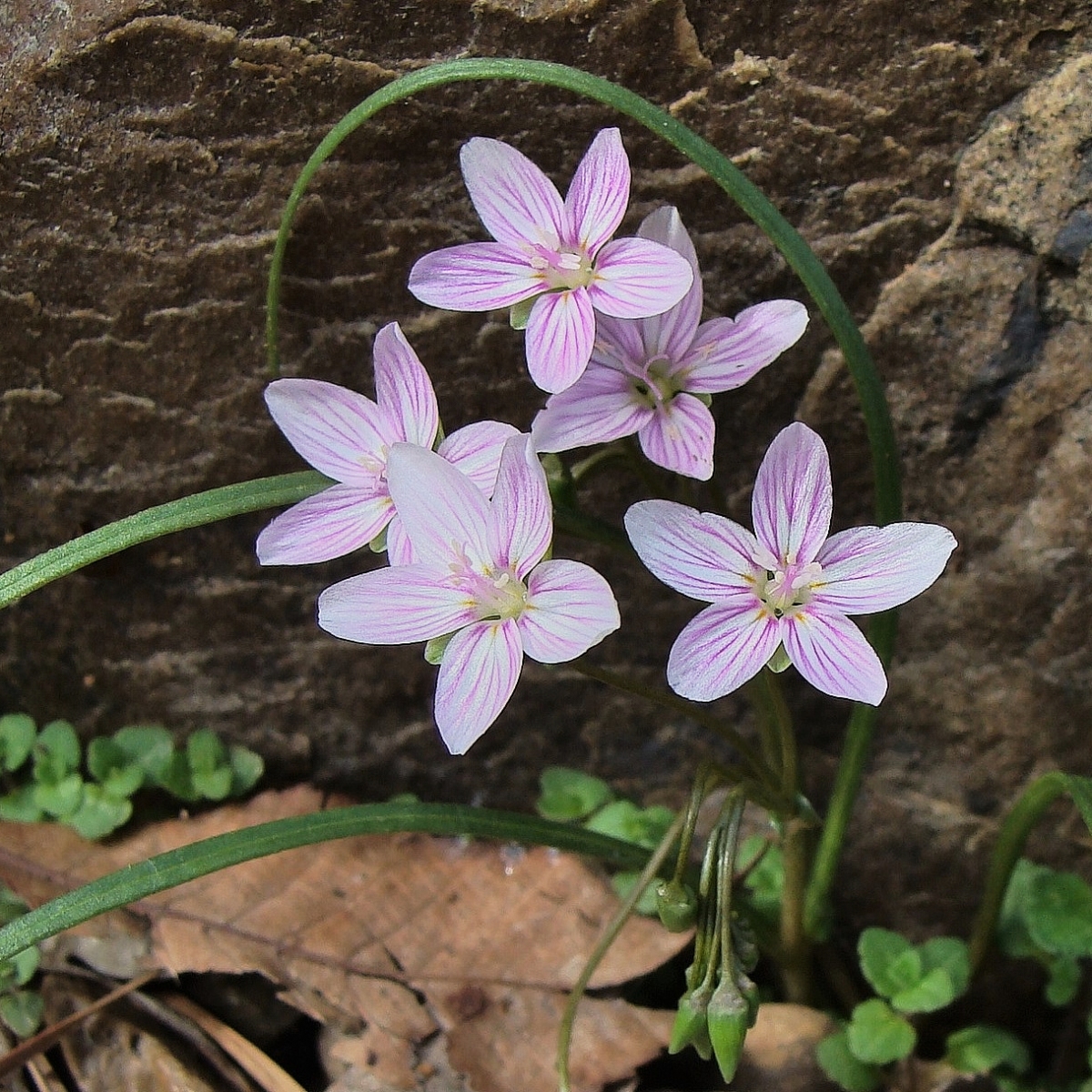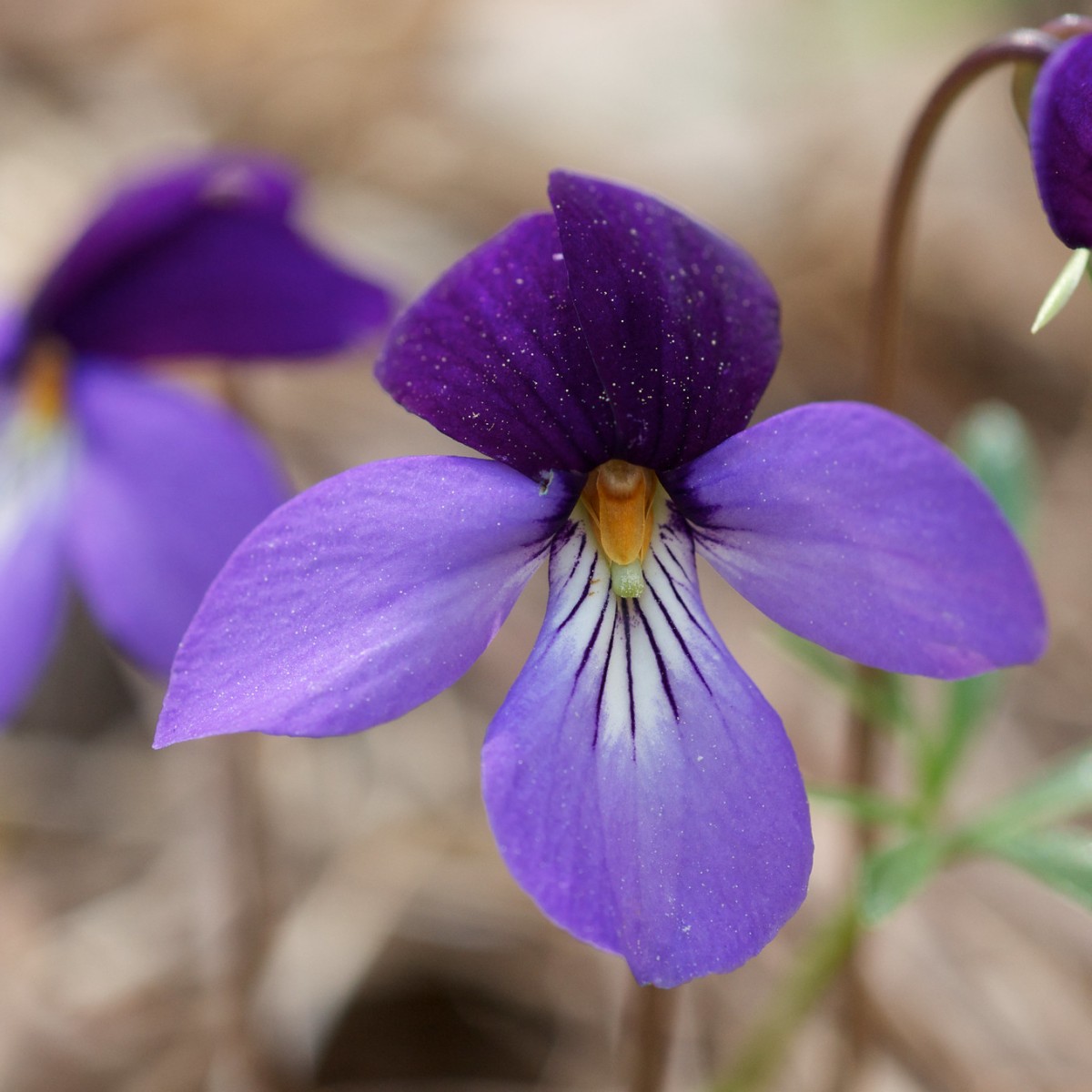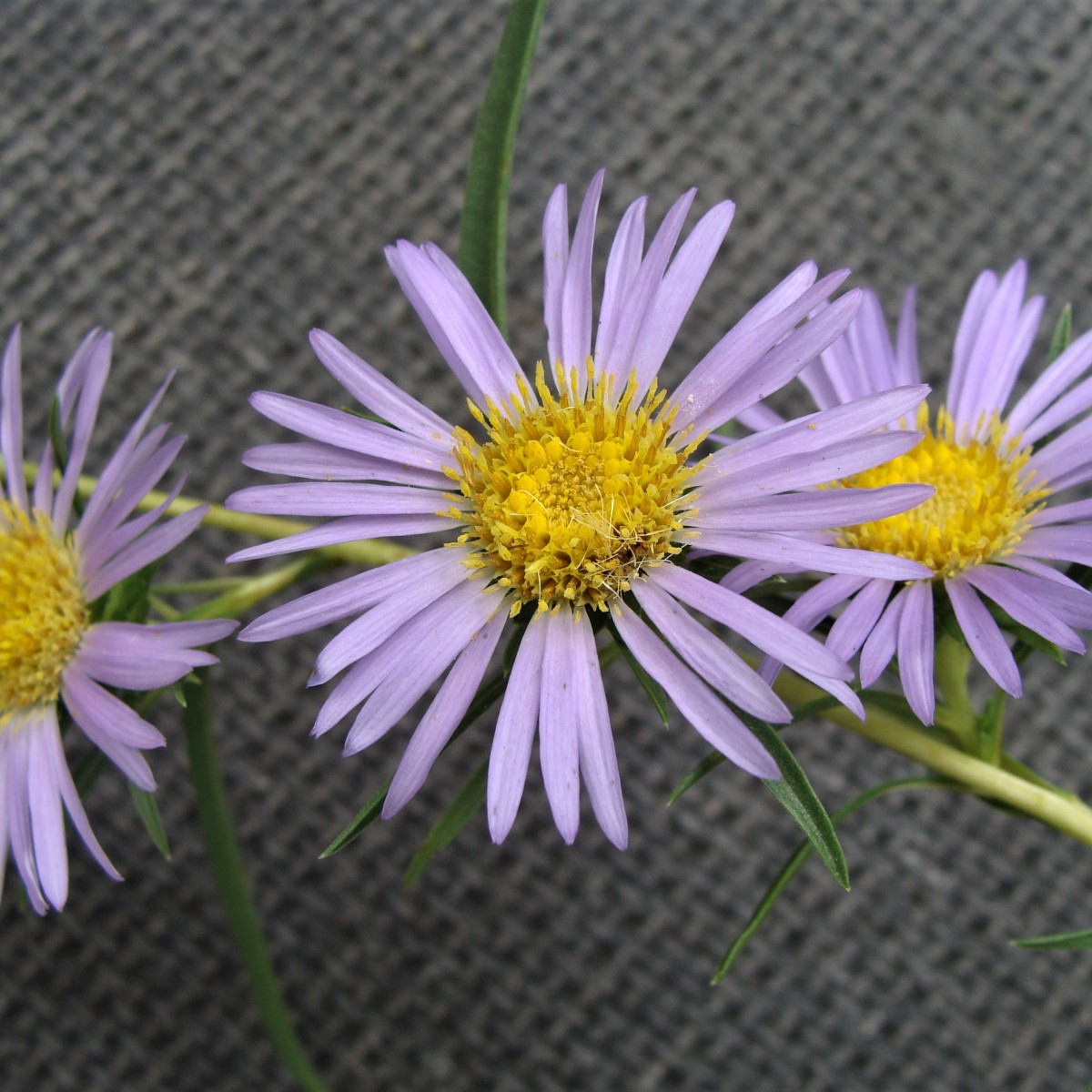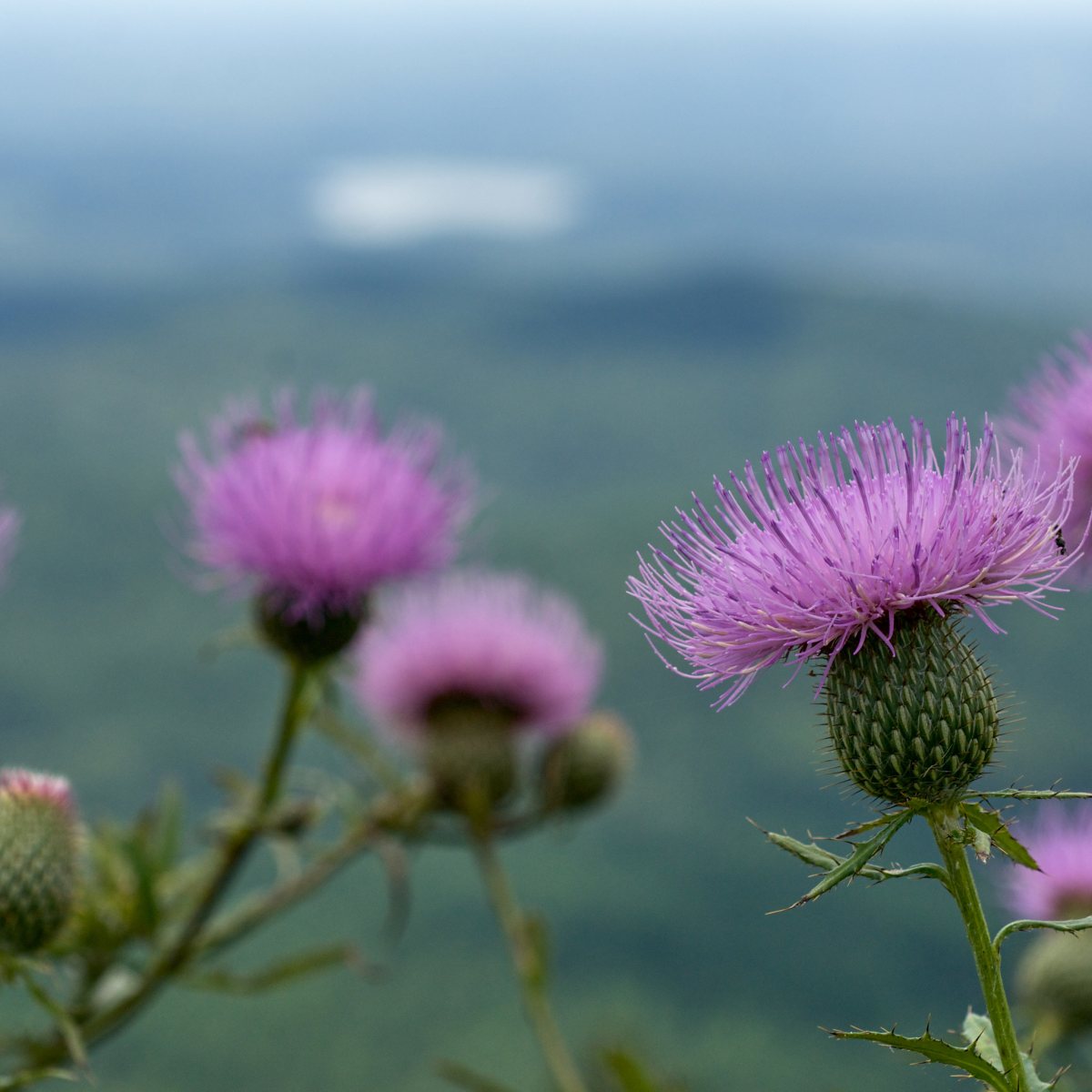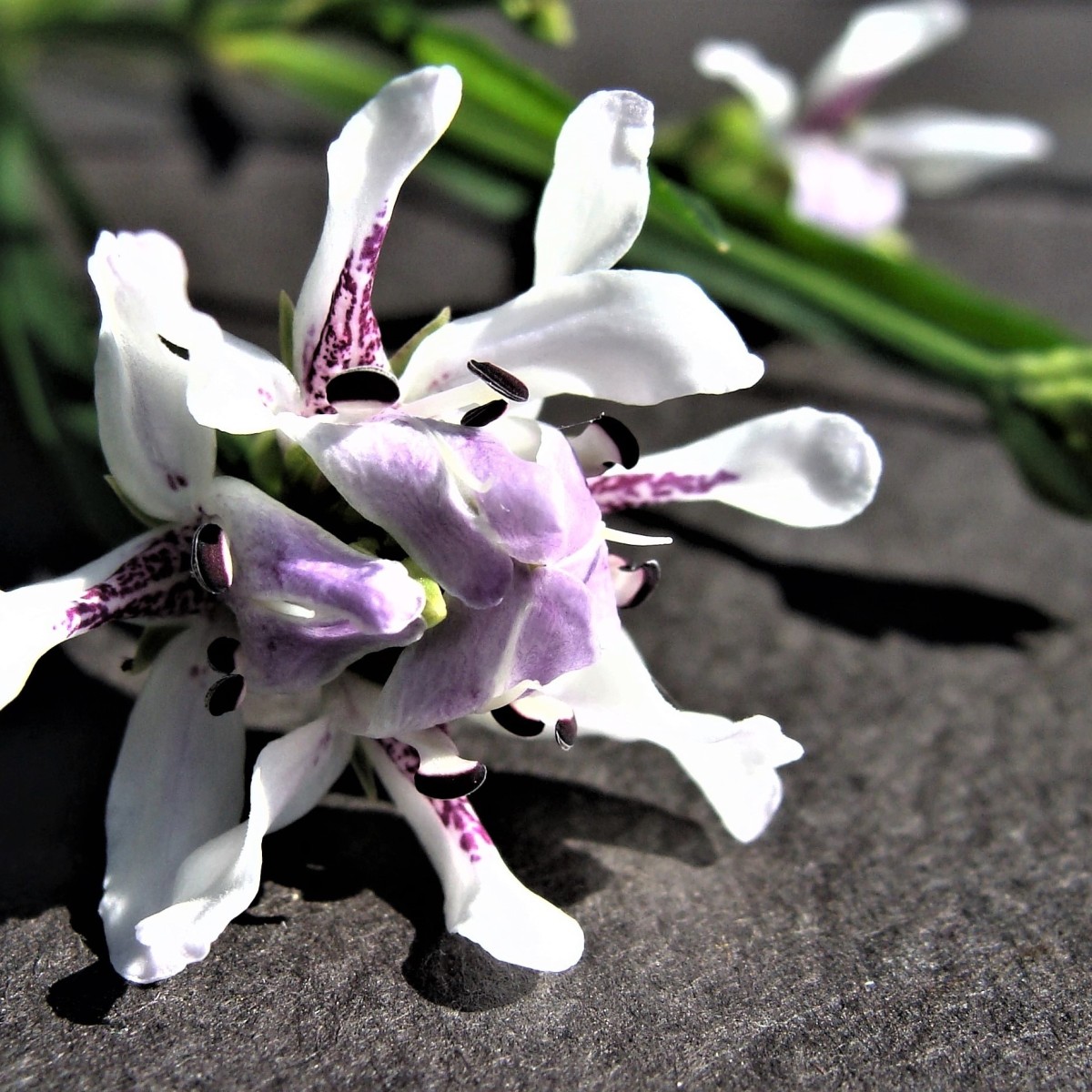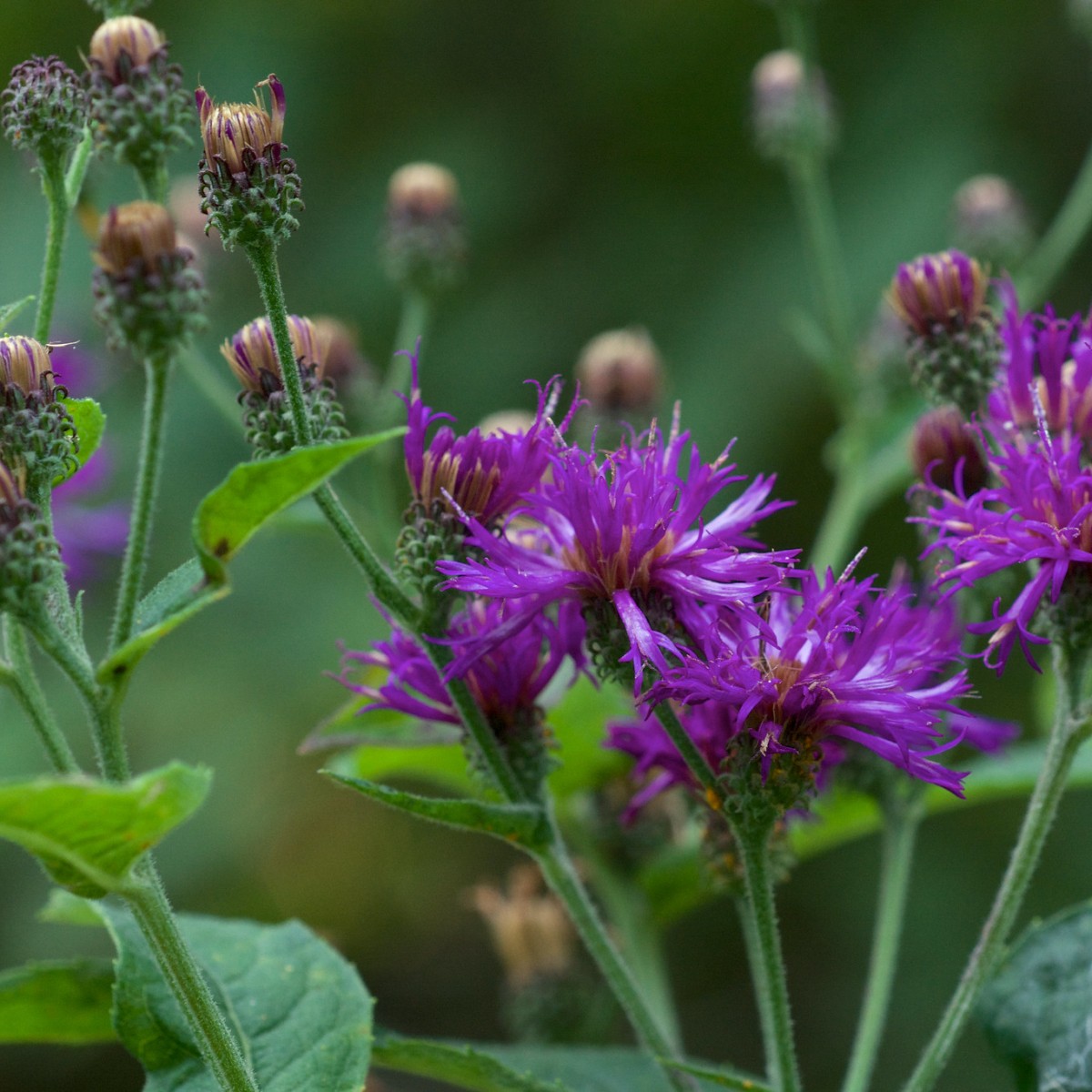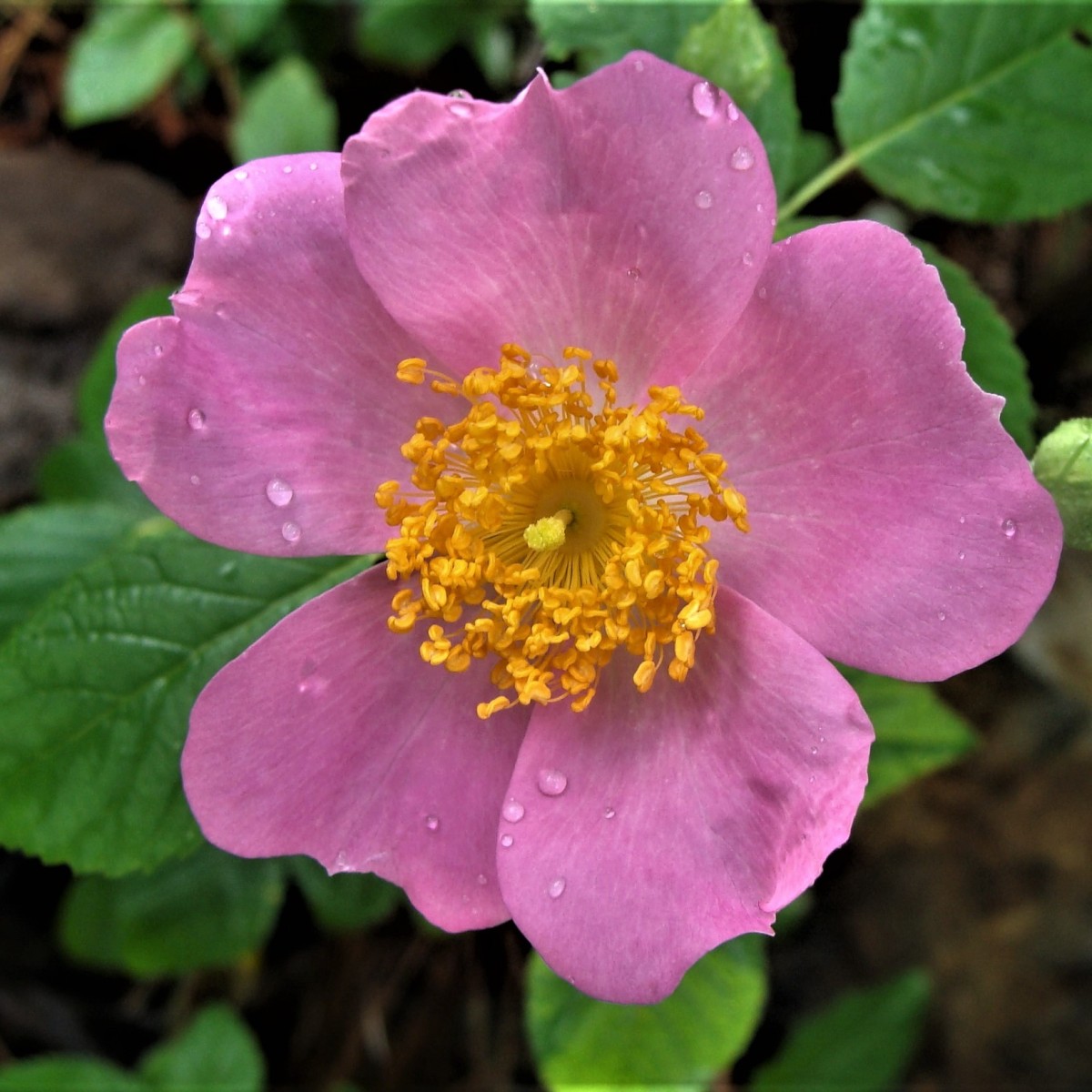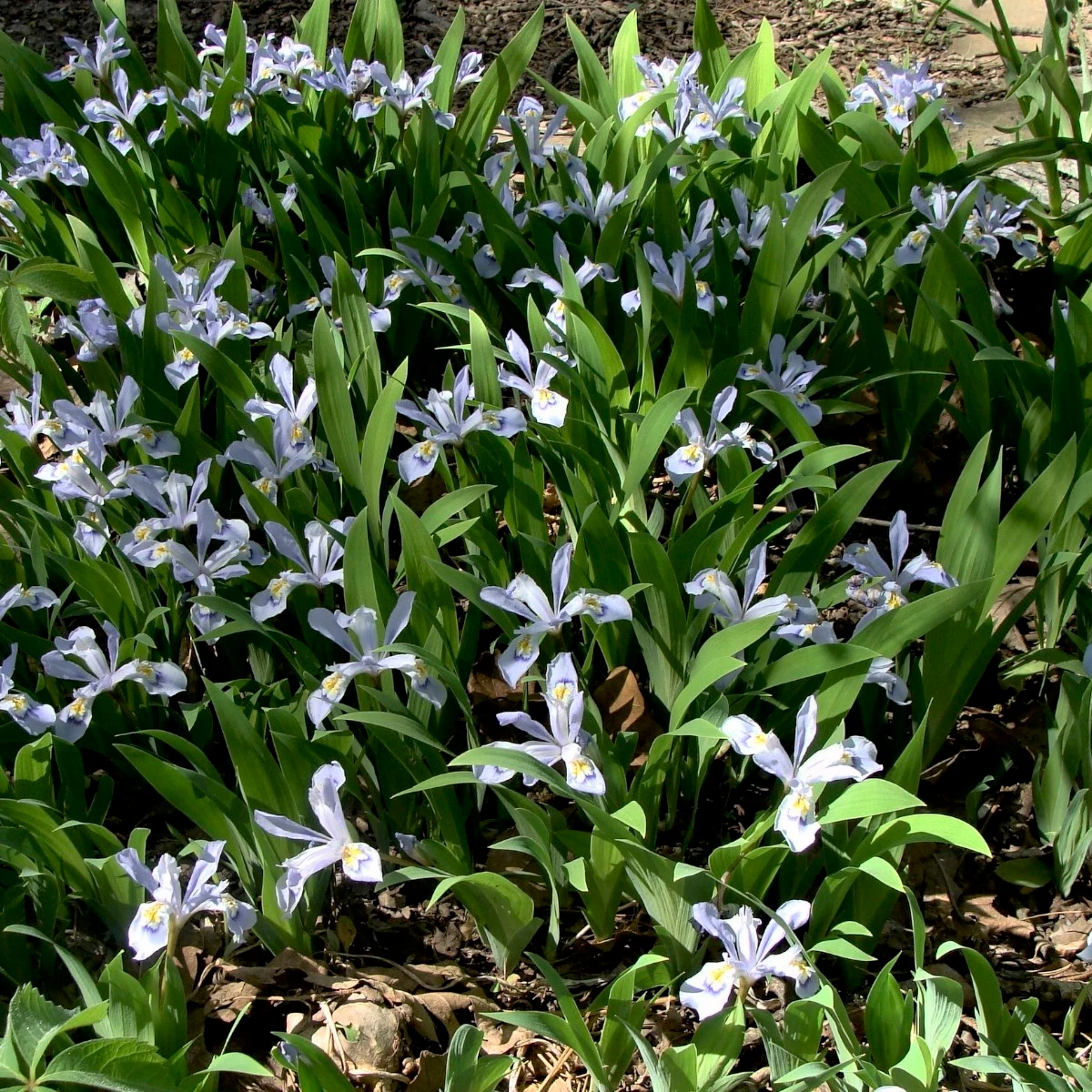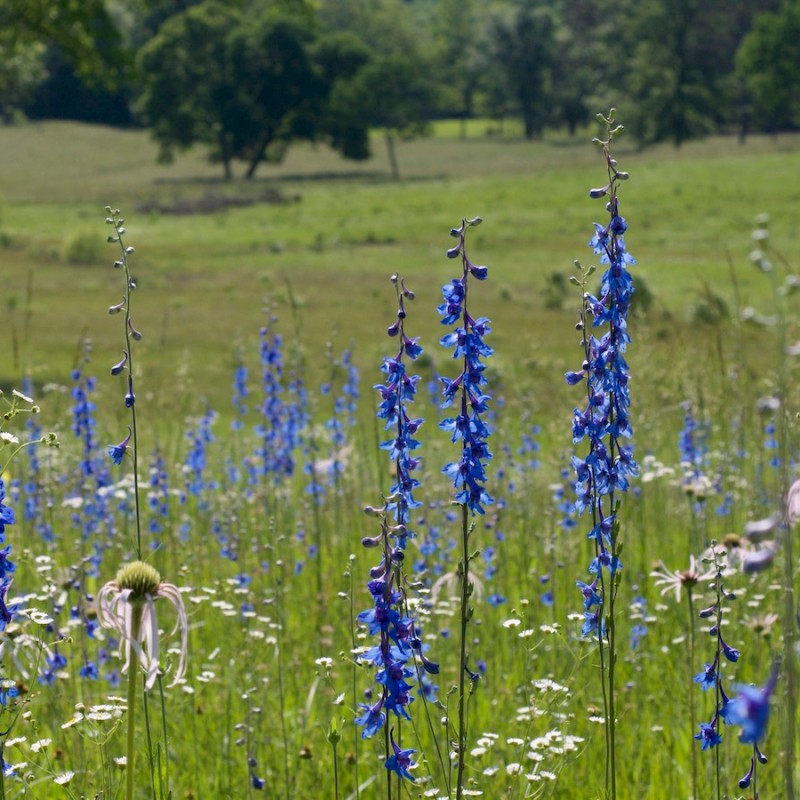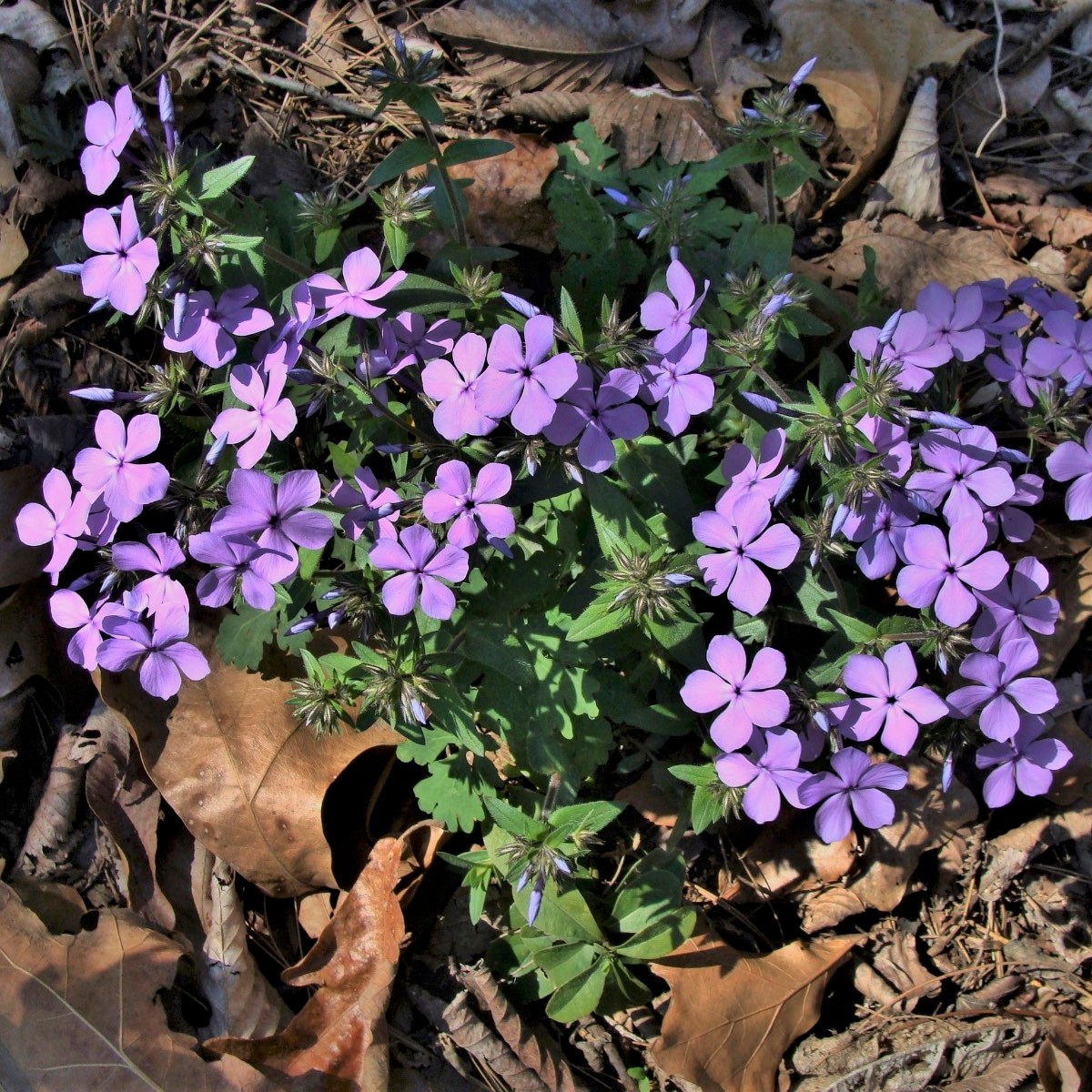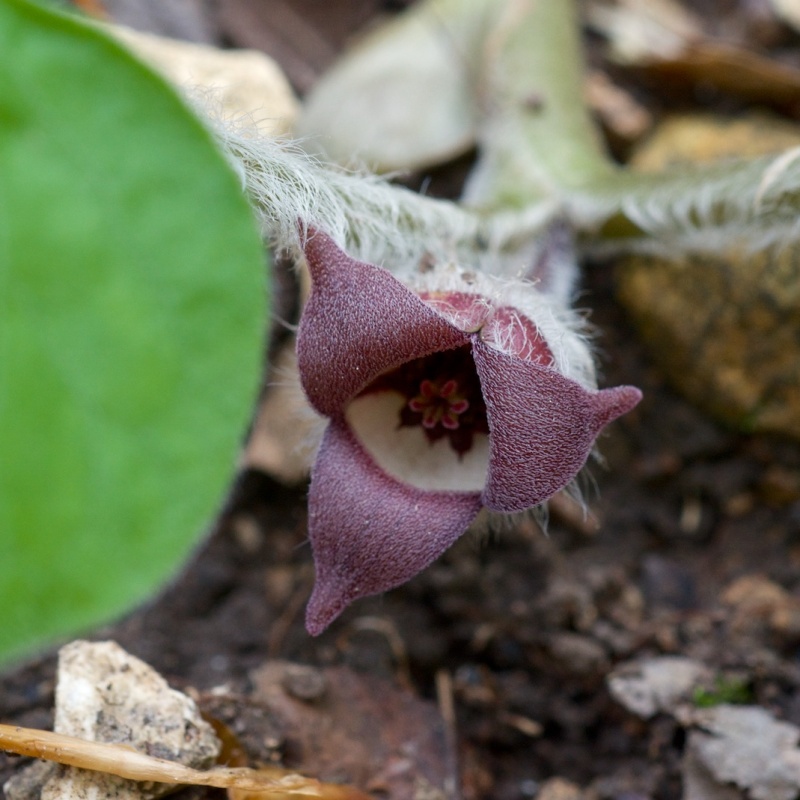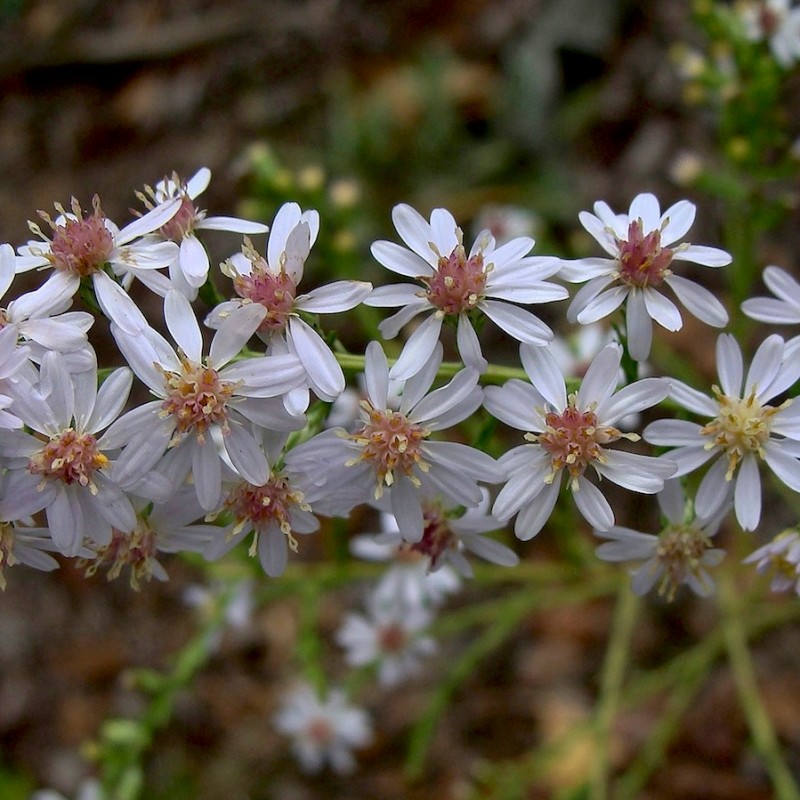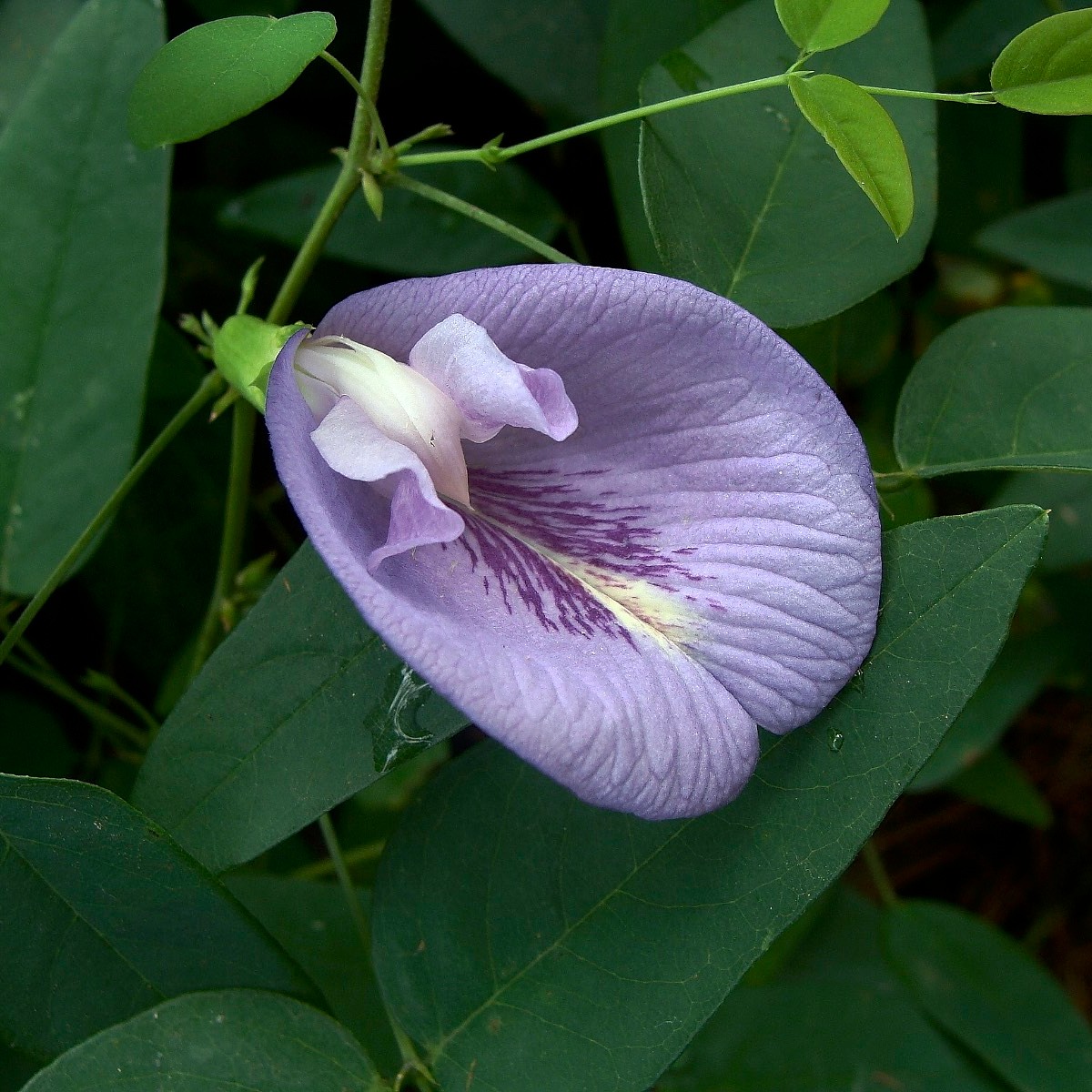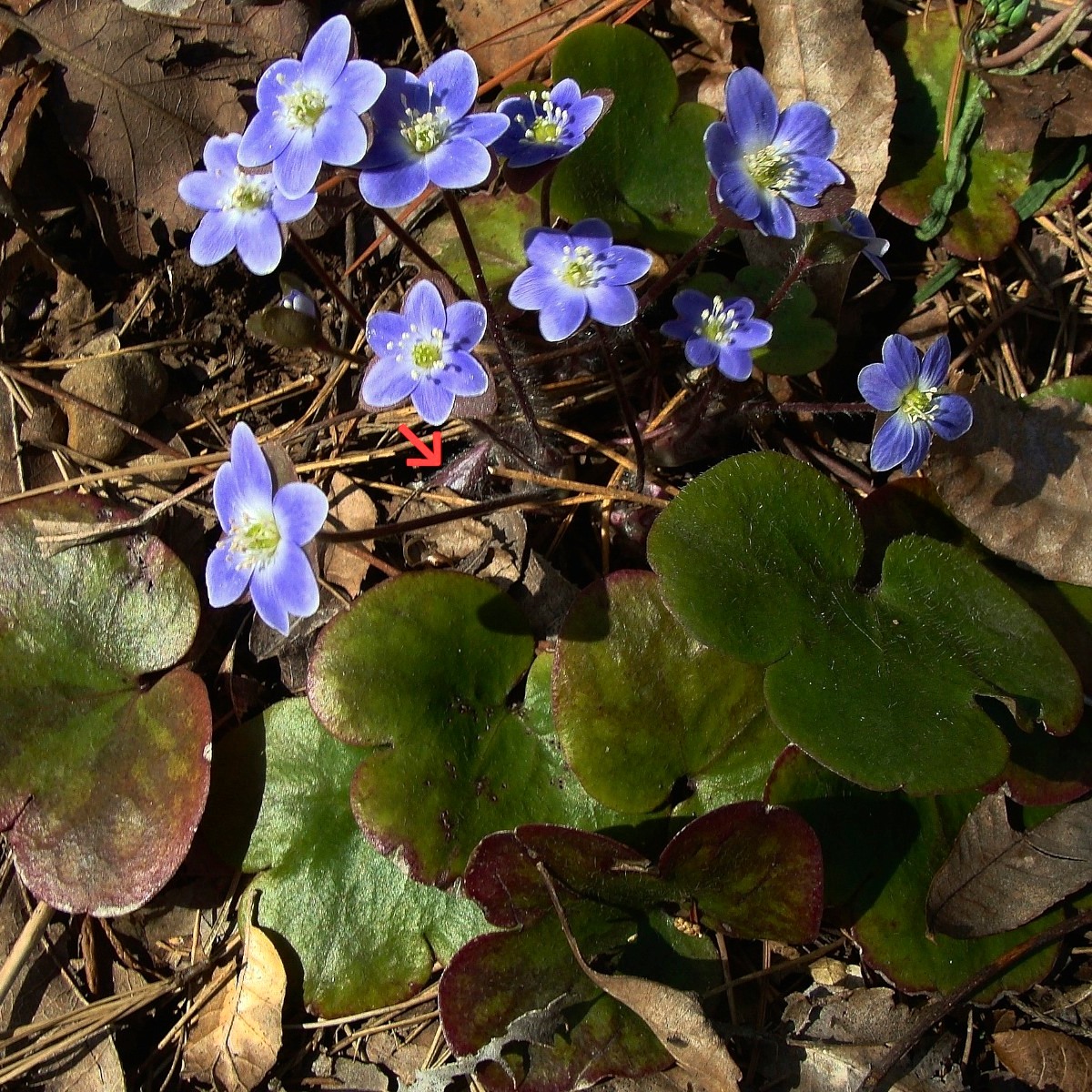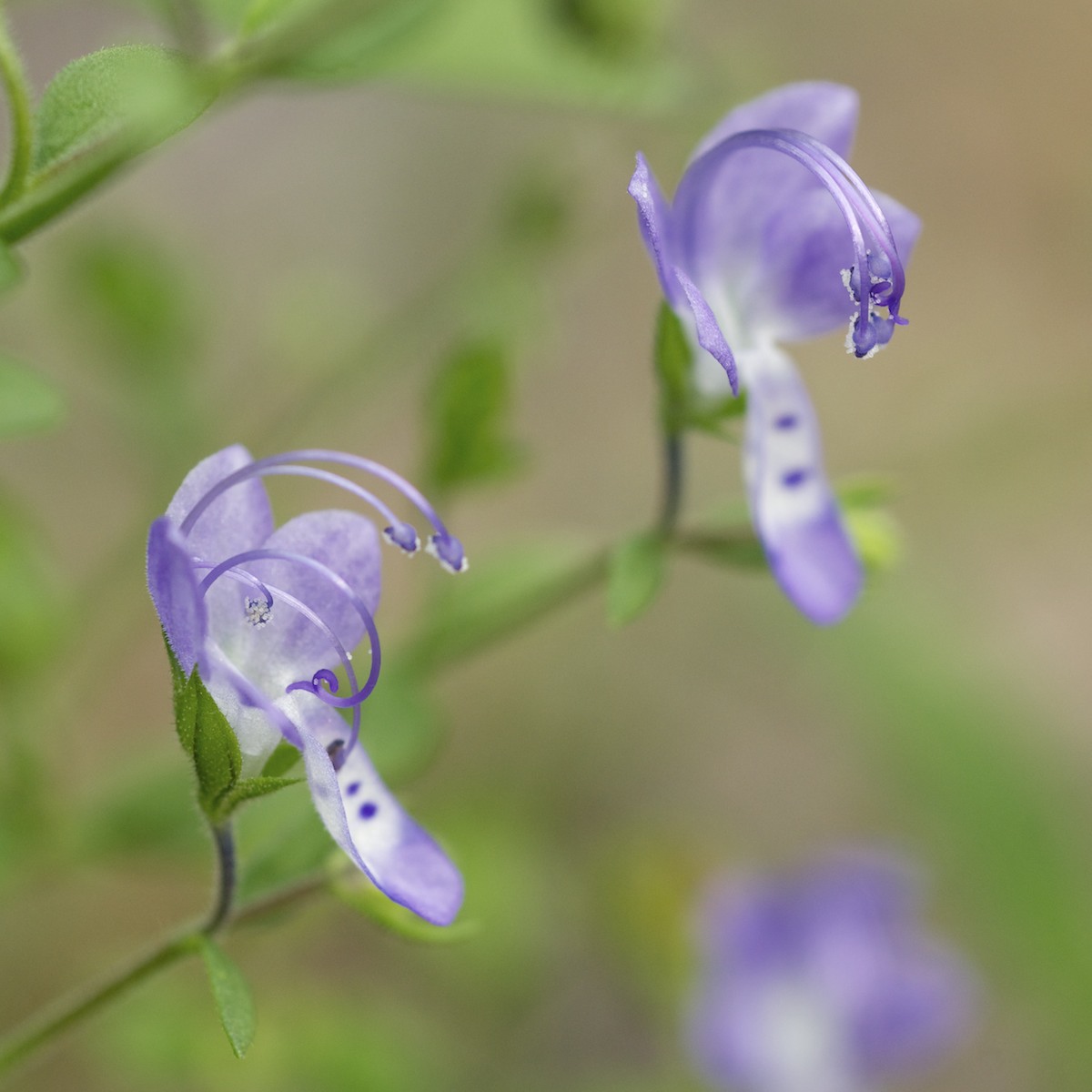Know Your Natives – White-Leaf Mountain Mint
White-Leaf Mountain Mint (Pycnanthemum albescens) of the Mint (Lamiaceae) family is a tall, upright perennial forb with a strong minty scent and has an open, gangly structure. The genus name is based on Greek words for dense (pyknos) and flower (anthos) in reference to its flower clusters. The specific epithet…
Know Your Natives – Clasping Venus’ Looking Glass
Clasping Venus’ Looking Glass (Triodanis perfoliata; formerly, Specularia perfoliata) of the Bellflower (Campanulaceae) family is an erect to reclined annual forb with clasping, ovate to orbicular leaves and both non-opening (cleistogamous – CL) flowers and opening (chasmogamous – CH) flowers. The genus name, based on Greek words for “three” and…
Know Your Natives – Downy Phlox
Downy Phlox (Phlox pilosa*) of the Phlox (Polemoniaceae) family is a semi-evergreen perennial forb with showy flowers of variable color and shape. The genus, Phlox, is derived from the Greek word meaning flame – a reference to flower color of some species. The specific epithet, pilosa, is from Latin meaning…
Know Your Natives – Downy Lobelia
Downy Lobelia (Lobelia puberula) of the Bellflower (Campanulaceae) family is a pubescent, herbaceous perennial bearing showy racemes of blue to lavender flowers. The genus name recognizes Matthias de l’Obel, a Flemish 16th-century physician and botanist who is credited with being the first to attempt to classify plants by attributes other than their…
Know Your Natives – Stalked Wild Petunia
Stalked Wild Petunia (Ruellia pedunculata ssp. pedunculata*) of the Acanthus (Acanthaceae) family has flowers with large, showy, trumpet-shaped, purplish corollas, similar to those of the unrelated Garden Petunia**. The genus name honors Jean de la Ruelle (1474-1537), a French herbalist. The specific epithet, from the Latin, refers to the prominent…
Know Your Natives – Purple Coneflower
Purple Coneflower (Echinacea purpurea) of the Sunflower or Composite (Asteraceae) family is an erect herbaceous perennial with large, showy, terminal flowerheads. The genus name is derived from a Greek word for “hedgehog” in reference to the spiny bracts that share the receptacle with the ray and disk florets. The specific…
Know Your Natives – Pale Purple Coneflower
Pale Purple Coneflower (Echinacea pallida) of the Aster or Composite (Asteraceae) family is a heavily pubescent herbaceous perennial with long lanceolate leaves and large, spectacular flowerheads. The genus name is derived from a Greek word for “hedgehog” in reference to the spiny bracts covering the head. The specific epithet is…
Know Your Natives – Showy Evening Primrose
Showy Evening Primrose (Oenothera speciosa) of the Evening-Primrose family (Onagraceae) is a colonial perennial with large pink to white flowers. The etymology of the genus name, used by Linnaeus, is ambiguous: It is apparently from a Greek word for wine seeker or sleep inducer or, quite on the other hand,…
Know Your Natives – Violet Blue-Eyed Mary
Violet Blue-Eyed Mary (Collinsia violacea) of the Plantain (Plantaginaceae) family, formerly of the Figwort (Scrophulariaceae) family, is an annual forb with attractive bi-colored flowers. The genus name honors Zaccheus Collins (1764–1831), a Philadelphia botanist. The specific epithet is Latin for “purple.” The species has a restricted range in the central…
Know Your Natives – Southern Woolly Violet
Southern Woolly Violet (Viola villosa) of the Violet (Violaceae) family is a small perennial herb with evergreen leaves and early flowers. The genus name is the classical Latin name for violets. The specific epithet is Latin for “hairy,” emphasizing the plant’s dense pubescence. Scattered populations occur across the southeastern U.S.…
Know Your Natives – Ouachita Hedge-Nettle
Ouachita Hedge-Nettle (Stachys iltisii*) of the Mint (Lamiaceae) family is a clonal herbaceous perennial with a spike-like inflorescence of two-lipped, white flowers with prominent purple blotches. The genus name is from the Greek for “an ear of wheat” in reference to the spike-like inflorescence. The specific epithet honors botanist Hugh…
Know Your Natives – Long-Flower Cornsalad
Long-Flower Cornsalad (Valerianella longiflora) of the Cornsalad (Valerianaceae) family is an intruigingly branched, herbaceous annual with white flowers with long purple floral tubes. The genus name is the diminutive of Valeriana, the type genus of the Valerianaceae, a name honoring the Roman emperor Valerianus. The specific epithet refers to the…
Know Your Natives – Rue-Anemone
Rue-Anemone (Thalictrum thalictroides; formerly Anemonella thalictroides) of the Buttercup (Ranunculaceae) family is a small, perennial, woodland ephemeral with an umbellate inflorescence of white to pink flowers. The genus name is the Latin form of the Greek word thaliktron, used in ancient times to describe some meadow-rues, possibly in reference to…
Know Your Natives – Carolina Horse Nettle
Carolina Horse Nettle (Solanum carolinense) of the Nightshade (Solanaceae) family is a toxic* perennial with attractive flowers and fruit and piercing prickles. The genus name is Latin for “quieting” in reference to the narcotic properties of some species. The specific epithet suggests that Linnaeus, who named the species, examined a…
Know Your Natives – Spring-Beauty
Spring-beauty (Claytonia virginica), traditionally treated as a member of the Purslane (Portulacaceae) family but more recently as a member of the Miner’s-lettuce (Montiaceae) family, is a widespread, common, native wildflower, a perennial herb with lovely white, pink-veined flowers. The genus name honors John Clayton, one of Colonial America’s earliest botanists.…
Know Your Natives – Bird’s-Foot Violet
Bird’s-foot violet (Viola pedata) of the Violet (Violaceae) family, the paragon of the violets, has distinctive leaves and large, exquisite flowers in several colors. The genus name is the classical Latin name for violets. The specific epithet, the Latin for “foot-like,” refers to leaf shape. In the U.S., bird’s-foot violet…
Know Your Natives – Southern Prairie Aster
Southern prairie aster (Eurybia hemispherica) of the Aster or Sunflower (Asteraceae) family is a slender stemmed plant with spectacular, inch-wide, lavender composite flowerheads. The genus name is based on Greek words for “wide” and “few,” a reference to big-leaf aster (Eurybia macrophylla), most likely to the ligules of the ray…
Know Your Natives – Tall Thistle
Tall thistle (Cirsium altissimum) of the Aster, Sunflower or Composite (Asteraceae) family is a tall biennial thistle with weak spines and pink to lavender flower heads. The genus name derives from a Greek root for “swollen vein” in reference to past use of the plants to reduce swelling. The specific…
Know Your Natives – Water-willow
Water-willow (Justicia americana) of the Acanthus (Acanthaceae) family is an herbaceous aquatic perennial with willow-like leaves. The genus name recognizes James Justice, an 18th-century Scottish author of horticultural books. The specific epithet denotes the plant’s area of primary occurrence. In the U.S., water-willow occurs primarily from eastern Oklahoma and Kansas…
Know Your Natives – Missouri Ironweed
Missouri ironweed (Vernonia missurica) of the Sunflower or Aster (Asteraceae) family has vivid purple to magenta composite flowerheads in midsummer. The primary area of occurrence extends from western Florida to eastern Texas, north and east to Indiana and southern Michigan. In Arkansas, the species occurs throughout most of the state,…
Know Your Natives – Baldwin’s Ironweed
Baldwin’s ironweed (Vernonia baldwinii) of the Sunflower or Aster (Asteraceae) family is a tall plant with a vivid purple inflorescence. In the U.S., it occurs principally from central Texas north to Nebraska and Iowa and east to Illinois and Arkansas. In Arkansas, it is found in the northwestern two-thirds of…
Know Your Natives – Climbing Rose
Flowers of climbing rose (Rosa setigera) of the Rose (Rosaceae) family, one of four native roses that occur in Arkansas, have a single layer of five pink (occasionally white) petals. The genus name is Latin for “rose,” the specific epithet, also Latin, means “bristle-bearing”. Climbing rose occurs in the U.S.…
Know Your Natives – Crested Iris
Crested iris or dwarf crested iris (Iris cristata) of the Iris (Iridaceae) family is a low-growing iris that produces light blue flowers in early spring. In the U.S., it occurs from Oklahoma, Arkansas and Missouri east to Atlantic Coastal states. In Arkansas, the species occurs across the Ozark Plateaus, Arkansas…
Know Your Natives – Hairy Skullcap
Hairy skullcap (Scutellaria elliptica) of the Mint (Lamiaceae) family is one of nine skullcap species known to occur in Arkansas. The genus name is from the Latin scutella, a dish, in reference to the distinctive shape of the lower portion of the fruiting calyx (see below). The specific epithet refers…
Know Your Natives – Ernest’s Spidewort
Ernest’s spiderwort (Tradescantia ernestiana) of the Commelinaceae (Spiderwort) family is an early-blooming, low-growing species, one of the 12 spiderworts that occur in Arkansas. The genus name honors John Tradescant, gardener to Charles I of England, while the specific epithet honors American botanist Ernest Jesse Palmer. This spiderwort occurs in Missouri,…
Know Your Natives – Carolina Larkspur
Carolina larkspur (Delphinium carolinianum subsp. carolinianum) of the Buttercup (Ranunculaceae) family has irregular (bilaterally symmetrical) springtime flowers that are typically deep blue. The genus name is based on a Greek word for “dolphin”, in reference to the shape of flower buds (when viewed from the side). The specific epithet is…
Know Your Natives – Woodland Phlox
Woodland phlox, blue phlox or wild sweet William (Phlox divaricata ssp. laphamii) of the Phlox (Polemoniaceae) family is the first phlox to bloom in the spring in Arkansas. The genus name is Greek for “flame,” in reference to many species of the genus with strongly colored corollas. The specific epithet,…
Know Your Natives – Obedient Plant
Obedient plant (Physostegia virginiana*) of the Mint (Lamiaceae) family is an attractive plant with showy late summer to early fall flowers. The genus name is from Greek words for “bladder” and “cover” in reference to the inflated calyx that covers maturing fruit. The specific epithet refers to the type locality,…
Know Your Natives – Hairy Blazing Star
Hairy blazing star (Liatris hirsuta*) of the Aster (Asteraceae) family has vibrant violet to lavender flowers, typical of many species in the genus. In the U.S., hairy blazing star is reported from Texas and northward to Nebraska and Iowa, with scattered reports in Mississippi, Alabama, and Georgia. In Arkansas, it…
Know Your Natives – Heart-leaf Skullcap
Heart-leaf skullcap (Scutellaria ovata*) of the Mint (Lamiaceae) family is one of 11 skullcaps** found in Arkansas that have blue to purple, two-lipped tubular flowers. Heart-leaf skullcap occurs from Texas and Minnesota east to the Gulf and Atlantic Coasts, as far north as Pennsylvania. In Arkansas, it occurs throughout much…
Know Your Natives – Sensitive Brier
Sensitive brier (or briar) (Mimosa quadrivalvis var. nuttallii*) of the Bean (Fabaceae) family is a sprawling perennial legume that is covered with prickles. The genus name is from a Greek word for “mime” or “mimic,” in reference to leaves in some species that fold when stimulated, suggestive of mimicking conscious life.…
Know Your Natives – Violet Wood Sorrel
Violet wood sorrel (Oxalis violacea) of the Wood Sorrel (Oxalidaceae) family is a small bulb-plant that bears shamrock-style leaves. The genus name is based on a Greek word for “acid”, in reference to the plant’s pleasantly sour taste. The specific epithet is Latin for “violet-colored”, referring to the flowers. It…
Know Your Natives – Wild Ginger
Wild ginger (Asarum canadense*) of the Dutchman’s-pipe (Aristolochiaceae) family is a low-growing woodland spring ephemeral. It occurs throughout the eastern U.S. from Louisiana and Oklahoma to North Dakota thence eastward to the Atlantic Coast, except Florida. In Arkansas, it occurs throughout the Interior Highlands (Ozarks, Arkansas Valley, and Ouachitas) as…
Know Your Natives – Rose Vervain
Rose vervain (Glandularia canadensis, formerly Verbena canadensis) of the Vervain (Verbenaceae) family is an herbaceous, low-growing plant with spikes of showy flowers. The genus name refers to glands found on many of the species. The specific epithet refers to the species’ occurrence in what was historically considered to be Canada but…
Know Your Natives – Drummond’s Aster
Drummond’s aster (Symphyotrichum drummondii) of the Aster (Asteraceae) family is a herbaceous perennial with disk flowers that change color with age. Preferred habitats are partially sunny upland sites in open deciduous woodlands and woodland borders along streams and roads. This aster occurs from Texas and Alabama north to Minnesota and…
Know Your Natives – Palafoxia
Palafoxia (Palafoxia callosa) of the Asteraceae (Aster or Composite) family is a drought tolerant annual herb. The genus name recognizes José de Palafox y Melzi (1776–1847), a Spanish officer in the war against Napeoleon. The specific epithet is derived from the Latin for “hardened,” from the tips of the bracteal…
Know Your Natives – White Four-O’Clock
White four-o’clock (Mirabilis albida) of the Four-O’Clock (Nyctaginaceae) Family is an herbaceous perennial that blooms from evening into the next morning. The genus name is from a Latin word meaning “wonderful”. The specific epithet is from Latin for “whitish”*. Another common name is pale umbrella-wort, in reference to the plant’s…
Know Your Natives – Butterfly Pea
Butterfly Pea (Clitoria mariana) of the Pea/Bean (Fabaceae) family, the only species of the genus occurring in Arkansas, has large pea-shaped flowers. In the U.S., it occurs from New Mexico to Kansas, Nebraska, and Minnesota, east to New York and thence southward to the coasts. It occurs statewide in Arkansas.…
Know Your Natives – Self-Heal
Self-heal (Prunella vulgaris ssp. lanceolata*) of the Mint (Lamiaceae) family is a perennial herb found in generally moist soils. It occurs as a native species throughout the lower 48 states and Alaska. In Arkansas, it occurs throughout the state. The origin of the genus name is not known. The specific…
Know Your Natives – Western Daisy
Western Daisy (Astranthium ciliatum) (formerly Astranthium integrifolium*), of the Aster (Asteraceae) family, is an annual species with daisy-like flower heads. In the U.S., it is found in Arkansas, Oklahoma, Texas, southern Nebraska and southwestern Missouri with greatest concentrations in eastern Oklahoma and western Arkansas. The genus Astranthium comprises about a…
Know Your Natives – Hairy Phacelia
Hairy phacelia (Phacelia hirsuta) of the Borage (Boraginaceae) family [formerly of the Waterleaf (Hydrophyllaceae) family] is a beautiful annual forb with blue flowers. In the U.S., it is found naturally in Arkansas, Louisiana, Texas, Oklahoma, Kansas, and Missouri, as well as introduced in Kentucky and Pennsylvania. In Arkansas, it is found throughout…
Know Your Natives – Wild Geranium
Wild geranium (Geranium maculatum) of the Geranium (Geraniaceae) family is an herbaceous woodland perennial that blooms in early spring. In the U.S., this species is found from Louisiana and Oklahoma to Florida and north to North Dakota and Maine. In Arkansas, it is found primarily in the highlands of the…
Know Your Natives – Dwarf Larkspur
Dwarf larkspur (Delphinium tricorne) of the Buttercup (Ranunculaceae) family has distinctive early spring flowers that are often dark bluish-purple (or sometimes white). Other common names include spring larkspur and rock larkspur. This species is typically found in rich alluvial deciduous woods and wooded rocky slopes in shady to partially sunny sites…
Know Your Natives – Dittany
Dittany (Cunila origanoides) of the Mint (Lamiaceae) family is a small, herbaceous perennial that produces “frost flowers”. Dittany, the only species of the Cunila genus in the U.S. (the rest are in Central and South America), occurs from northeast Texas to extreme southeast Kansas to New York, thence south to Louisiana,…
Know Your Natives – Beautyberry
Beautyberry (Callicarpa americana) of the Mint (Lamiaceae) family, formerly of the Vervain (Verbenaceae) family, is a large deciduous shrub that occurs throughout the Southeastern U.S. from Texas and Oklahoma to southern Missouri and southwestern Kentucky, to Maryland, thence south and east to the coasts. In Arkansas, it is recorded from across the state but…
Know Your Natives – Joe Pye Weed
Joe Pye weed (Eutrochium purpureum*) of the Aster (Asteraceae) family occurs in the U.S. from Louisiana and Oklahoma, north to South Dakota and Minnesota, thence east and south to the borders. In Arkansas, this species occurs in the Ozark and Ouachita Mountains, higher elevations of the Arkansas River Valley, and on Crowley’s…
Know Your Natives – American Germander
American germander (Teucrium canadense var. canadense) of the Mint (Lamiaceae) family occurs across the eastern half of the U.S. In Arkansas, it is found statewide. Also known as wood sage and Canada germander, this is the only species of the genus known in Arkansas. The genus is believed named in honor…
Know Your Natives – Net-leaf Leather-flower
Net-leaf leather-flower (Clematis reticulata*) of the Buttercup (Ranunculaceae) family is a perennial herbaceous vine found in portions of the Southeastern U.S from eastern Texas and Oklahoma to South Carolina and Florida. In Arkansas, the species is recorded from north-central and southwestern parts of the state. It is found in mesic to dry,…
Know Your Natives – Carolina Rose
Carolina rose (Rosa carolina) of the Rose (Rosaceae) family occurs in the U.S. from Texas to Nebraska to Minnesota thence east and south to the borders. In Arkansas it occurs throughout the state. The genus name is Latin for “rose.” The specific epithet refers to the type location for the…
Know Your Natives – Large-Flower Baby-Blue-Eyes
Large-flower baby-blue-eyes (Nemophila phacelioides) of the Borage (Boraginaceae) family, formerly of the Waterleaf (Hydrophyllaceae) family, is a showy native wildflower endemic to the south-central U.S. that has been recorded in only four states; namely Arkansas, Louisiana, Texas and Oklahoma. In Arkansas it is known from throughout the Ouachita Mountains and the…
Know Your Natives – Dutchman’s Breeches
Dutchman’s breeches (Dicentra cucullaria) of the Poppy (Papaveraceae) family, formerly of the Fumitory (Fumariaceae) family, is found throughout much of the eastern U.S. from North Dakota to Maine southward to Oklahoma and South Carolina. Curiously, it is also found in Washington, Oregon and Idaho. In Arkansas, Dutchman’s breeches is found primarily throughout the Ozark Mountains, but it…
Know Your Natives – Round-Lobe Hepatica
Round-lobe hepatica (Anemone americana) of the Buttercup (Ranunculaceace) family, also called liverleaf*, is one of the first non-woody plants to bloom in spring. The species is found in the U.S. primarily from Mississippi, Alabama, and northern Florida, north through New England, and then west through the Great Lakes region. A separate…
Know Your Natives – Forked Blue-curls
Forked blue-curls (Trichostema dichotomum) of the Mint (Lamiaceae) Family is an herbaceous annual. It occurs throughout much of the eastern U.S. from Texas to Iowa and Michigan, to Maine and thence eastward and southward. In Arkansas, it is found throughout much of the state except for the bulk of the Mississippi…

